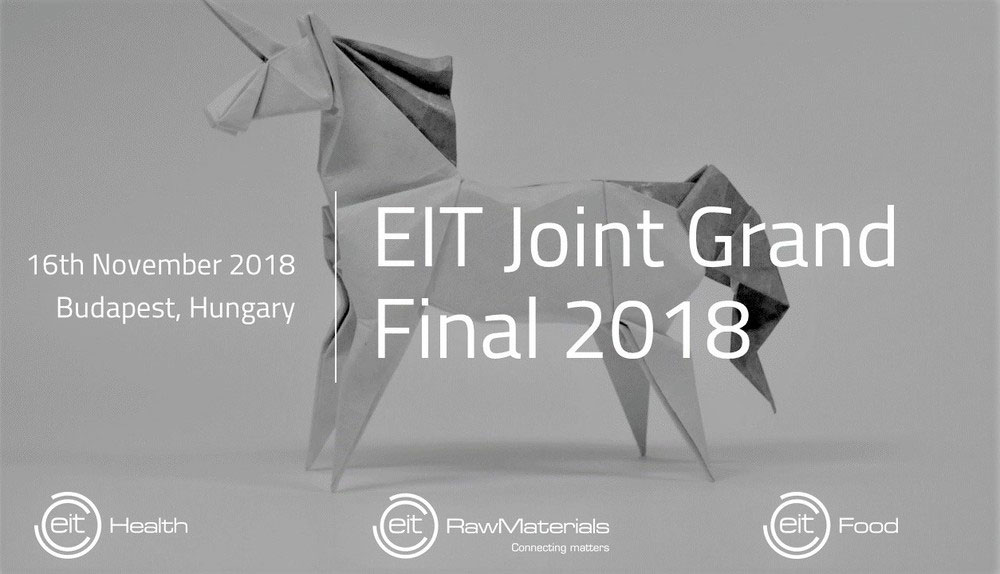EIT Joint Grand Final 2018 gathered the top innovative start-ups and teams from Central-Eastern and Southern Europe
On 16 November 2018, the best 40 innovative start-ups and teams from Central-Eastern and Southern Europe pitched in front of international investors, corporate partners and the EIT Community’s network at the EIT Joint Grand Final in Budapest, Hungary. The event was a great opportunity to find partnerships and design a start-up journey at the EIT Community’s largest thematic pitching competition in Central-Eastern and Southern Europe.
The keynote speakers included Martin Kern, Interim Director of the European Institute of Innovation and Technology (EIT), Sebastian F Kowitz, Founder and CEO of Talpasolutions, one of the start-ups supported by EIT RawMaterials, and Dr Gyula Dékány, Founder of Glycom and CarboCode.
The next generation of innovators
EIT RawMaterials together with EIT Health and EIT Food gathered the finalists of the Joint Business Idea Competition to select top innovators.
Start-ups pitched in front of a jury represented by Aristides Senra Díaz, Director of Innovation & Entrepreneurship Programs, Centro de Apoyo a la Innovacíon Tecnológica, Universidad Politécnicade Madrid, Giorgio Recine, Co-Founder and Partner, New Ideas 4.0 S.r.l., Nora Groth, Business Development Manager Innovation Hub (CLC) Central, EIT RawMaterials.
This is our second EIT Joint Grand Final and the second year of the Joint Business Idea Competition. Initially, this was an experiment, but it turned out to be much more efficient and valuable, not only for our KICs, but also for the participants from such different thematic areas. What our previous participants emphasize in their feedback particularly, is our interdisciplinary and international approach. Not only does it provide the participants with a comprehensive view of their respective margins, but, above all, it also shows how much we can all help each other. Innovation does not arise in isolation but comes from the mixture of different information and aspects; nothing can be excluded.
Krzysztof Kubacki, EIT RawMaterials Innovation Hub Director CLC East
Congratulations to the winning teams in categories of primary and secondary raw materials production!
Winners of the raw materials category: Primary Production
- BIOMOBILE
Ecological and economical technology applied through our mobile pilot plant will provide biotreatment to obtain high-quality nonmetallic raw materials, safe biomining of REE/CRM/metals from ores/low-grade ores/mining waste and cleaning of highly contaminated environment from dangerous but valuable heavy metals together with their recovery. By using local primary and secondary raw materials resources in the EU, we will reduce our dependence on import, improve the quality of the environment and thus positively affect the EU inhabitants health.
- Atium
Atium is developing a more effective and sustainable technology for removing toxic heavy metals from water. Through our patent-pending reusable technology, we create value by enabling efficient removal of low concentrations of heavy metals, without producing any secondary waste nor requiring consumables.
- GRAI
GRAI is aimed at making grinding process input fluctuations less threatening for the mineral plant productivity and reduces its potential to lead to the power drop events. To make that possible, GRAI utilizes the big data and artificial intelligence approaches. That is supposed to provide mineral processing plant owners with an opportunity to increase the grinding energy efficiency by up to 5-20%.
- mecorad GmbH
mecorad offers customers producing hot-rolled steel and metals higher quality of products at lower production costs by using a radar-based plant digitalisation solution. At any process step, we measure thickness, width and length of sheets and strip metal with an accuracy significantly below 100 µm, optimize these processes with our applications and connect into systems along the value chain.
- 3A Water
3A water is developing on-site real-time metal analysis of water.
Winners of the raw materials category: Secondary Production
- CradleCar
CradleCar takes back used batteries, analyses them and will always take the best decisions for each component’s recovery strategy. The batteries are disassembled, sorted, remanufactured and new batteries can be built. The remaining components will be put into the specific recycling routes.
- JPM Silicon
We up-cycle low-quality silicon waste from production of solar cells to high-quality silicon metal. This can be used as a fresh feedstock for the production of solar silicon and subsequently solar cells.
- Smart Symbiotech AS
Nutrient recycling technologies and industrial symbiosis in wastewater treatment are our aims. In that sense, natural porous materials can help us to achieve our circular economy approach.
- PCBIS
Closing the circle of waste printed circuit boards by adopting sustainable technologies for metal recovery.
- RoboCat
RoboCat wants to revolutionize the chemical industry by 3D-printing catalysts. This will increase the sustainability as well as the profitability of those processes.




